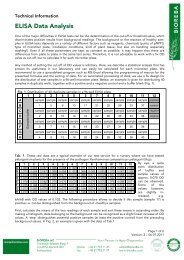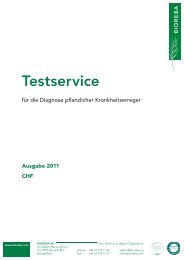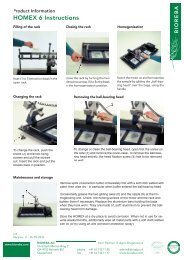Potato virus Y (PVY) - Bioreba
Potato virus Y (PVY) - Bioreba
Potato virus Y (PVY) - Bioreba
Create successful ePaper yourself
Turn your PDF publications into a flip-book with our unique Google optimized e-Paper software.
Product Information: DAS-ELISA<br />
<strong>Potato</strong> <strong>virus</strong> Y (<strong>PVY</strong>)<br />
Introduction to potato <strong>virus</strong> Y (<strong>PVY</strong>)<br />
In <strong>PVY</strong> of potatoes, several strain groups are distinguished according to the symptoms on Nicotiana tabacum,<br />
Physalis floridana, Solanum tuberosum and other potato cultivars (4). The main groups are: the common (<strong>PVY</strong>O ),<br />
tobacco veinal necrosis (<strong>PVY</strong>N ), and stipple streak (<strong>PVY</strong>C ) strain groups of <strong>PVY</strong>. More recently, subgroups within the<br />
historical groups have been described. For example within the <strong>PVY</strong>O group, atypical isolates, originating mostly<br />
from pepper and tobacco, have been assigned to the subgroup <strong>PVY</strong>Ob , whereas the common European potato<br />
isolates are called <strong>PVY</strong>Oa (8). Within <strong>PVY</strong>N , subgroups are represented by more recently described isolates such as<br />
<strong>PVY</strong>NTN (involved in the potato tuber necrotic ringspot disease) (9) and the Wilga type <strong>PVY</strong>NW (2). The latter one<br />
(<strong>PVY</strong>NW) is biologically similar to the «old» N-type (inducing typical necrosis on tobacco), but serologically similar<br />
to the O-type (no reaction with our «<strong>PVY</strong>-necrotic» reagent). Details of detection of these isolates with our <strong>PVY</strong><br />
reagents are given below in the section specificity and are illustrated in Table 1.<br />
BIOREBA AG has collaborated since 1980 with the Swiss Federal Research Station Agroscope Changins-Wädenswil<br />
(ACW, Nyon), and other institutes elsewhere for the development of ELISA reagents (7, 8). These collaborations<br />
allow us to adjust our reagents to new knowledge and new findings as needed. In this regard, we, in cooperation<br />
with the ACW, were able to modify and thus optimize our full-spectrum <strong>PVY</strong> reagent («<strong>PVY</strong> monoclonal cocktail»)<br />
introduced many years ago (for details see below).<br />
We rely as much as possible on monoclonal antibodies (Mab) for our reagents, since Mab provide several advantages<br />
over polyclonal antibodies (Pab):<br />
The reagent based on Mab guarantees a well defined and standardized product (constant in specificity and<br />
avidity), whereas Pab-based reagents inevitably introduce some variability between batches originating<br />
from different animals. Once developed, Mab are reproducible year after year.<br />
Different complementary Mab can be mixed in a controlled manner in order to broaden its serological<br />
range as it has been done for example with our «<strong>PVY</strong> monoclonal cocktail». This approach using Pab may<br />
lead to increased non-specific reactions. On the other hand, Mab are suitable for differentiating <strong>PVY</strong>N •<br />
•<br />
subgroups (example described in section D below).<br />
• Pathogen-specific Mab do not contain antibodies against host plant proteins that might interfere in the<br />
test. Therefore, non-specific background in ELISA is generally decreased, rendering the test more sensitive<br />
(wider OD ratio between infected and healthy tissue). But there are exceptional cases where non-specific<br />
reactions with Mab do occur (non-specific reactions with certain plant components?).<br />
Our reagents have been extensively tested in Europe and at the International <strong>Potato</strong> Center (CIP) in Peru and were<br />
found to be very efficient (W. Bitterlin and P. Gugerli, unpublished; COST 88 <strong>PVY</strong> ring-test, unpublished; 5, 7, 10).<br />
Furthermore, they have been used since the early 1980’s by many scientists and in numerous potato certification<br />
laboratories in many parts of the world.<br />
Specificity of reagents in DAS-ELISA (see also Table 1)<br />
A. The traditional broad-spectrum <strong>PVY</strong> reagent («<strong>PVY</strong> monoclonal»), made against isolate <strong>PVY</strong> N 605 and on<br />
the market since 1982, recognizes isolates belonging to the tobacco veinal necrosis (<strong>PVY</strong> N ), common (<strong>PVY</strong> O ) and<br />
stipple streak (<strong>PVY</strong> C ) strain groups of <strong>PVY</strong> (7). The reagent is based on a monoclonal antibody (Mab) to a common<br />
antigenic determinant. All of today’s known <strong>PVY</strong> isolates are recognized by this Mab with the exception of a few<br />
atypical isolates (e.g. <strong>PVY</strong> O 768) belonging to subgroup <strong>PVY</strong> O b (8). This reagent also recognizes <strong>PVY</strong> NTN (involved in<br />
the potato tuber necrotic ringspot disease) (9) and the Wilga type <strong>PVY</strong> N W (2). The reagent has proven its validity<br />
over the past quarter of a century in variable testing set-ups all over the world. As the first monoclonal-based reagent<br />
that became commercially available for phytodiagnostics, it really has become a true <strong>PVY</strong> standard reagent.<br />
Page 1 / 4<br />
www.bioreba.com<br />
BIOREBA AG Your Partner in Agro-Diagnostics<br />
Christoph Merian-Ring 7<br />
CH-4153 Reinach BL1 phone +41 61 712 11 25 admin@bioreba.ch<br />
Switzerland fax +41 61 712 11 17 www.bioreba.com
2<br />
B. The full-spectrum <strong>PVY</strong> reagent («<strong>PVY</strong> monoclonal cocktail«) contains complementary monoclonal antibodies<br />
to isolates from different strain groups (7, 8). It recognizes the whole range of <strong>PVY</strong> isolates from the tobacco veinal<br />
necrosis (<strong>PVY</strong> N ), common (<strong>PVY</strong> O ) and stipple streak (<strong>PVY</strong> C ) strain groups of <strong>PVY</strong> (Table 1). All recently described<br />
isolates such as <strong>PVY</strong> O 768 (belonging to subgroup <strong>PVY</strong> Ob ) (8) or <strong>PVY</strong> NTN (involved in the potato tuber necrotic ringspot<br />
disease) (9) and the Wilga type <strong>PVY</strong> N W (2) are also recognized. This reagent generally gives a more uniform reaction<br />
with the <strong>virus</strong> and a lower background than polyclonal antibodies from rabbit or sheep serum. The current reagent<br />
that became available in 2002 is an improved version of the reagent introduced in 1994. It consists of a «cocktail»<br />
of different complementary monoclonal antibodies. No cross-reaction with any other known potato <strong>virus</strong> has been<br />
observed.<br />
C. The polyclonal <strong>PVY</strong> reagent («<strong>PVY</strong> polyclonal«) was made against isolate <strong>PVY</strong> N 605. It recognizes, similar to<br />
«<strong>PVY</strong> monoclonal cocktail», the whole range of isolates from the tobacco veinal necrosis (<strong>PVY</strong> N ), common (<strong>PVY</strong> O )<br />
and stipple streak (<strong>PVY</strong> C ) strain groups of <strong>PVY</strong>, including the more recently described isolates such as <strong>PVY</strong> O 768<br />
(belonging to subgroup <strong>PVY</strong> Ob ) (8) or <strong>PVY</strong> NTN (involved in the potato tuber necrotic ringspot disease) (9) and the Wilga<br />
type <strong>PVY</strong> N W (2). But contrary to the monoclonal-based reagent, some variability from batch to batch in recognizing<br />
isolates of different strain groups is inevitable with the polyclonal-based reagent.<br />
D. The necrotic strain group-specific <strong>PVY</strong> reagent («<strong>PVY</strong> necrotic») specifically recognizes isolates belonging to<br />
the tobacco veinal necrosis (<strong>PVY</strong> N ) strain group of <strong>PVY</strong> («old» N-type group), including subgroup of <strong>PVY</strong> NTN (involved in<br />
the potato tuber necrotic ringspot disease) (9). In an independent study, carried out in 1991 (COST 88 <strong>PVY</strong> ring-test,<br />
unpublished), where nearly 50 <strong>PVY</strong> isolates from Europe and other continents were compared in biological and<br />
serological tests, all isolates of <strong>PVY</strong> N (old N-type group) were recognized with our <strong>PVY</strong> N reagent. On the other hand,<br />
Wilga type <strong>PVY</strong> N W isolates (2) are not recognized (<strong>PVY</strong> N W isolates are recognized with our other <strong>PVY</strong> reagents, i.e.<br />
«<strong>PVY</strong> monoclonal», «<strong>PVY</strong> monoclonal cocktail», and «<strong>PVY</strong> polyclonal» described in sections A, B and C). Our <strong>PVY</strong><br />
reagents thus provide a suitable tool for differentiating <strong>PVY</strong> N subgroups (M. Chrzanowska, personal communication,<br />
and 2). The <strong>PVY</strong> N reagent is based on monoclonal antibodies, developed against <strong>PVY</strong> N 605 (7, 8). The coating reagent<br />
consists of broad-spectrum, the conjugate of N-specific Mab (7). The <strong>PVY</strong> N reagent has been developed for double<br />
antibody sandwich ELISA (DAS-ELISA) (3, 6). This format is essential to ensure the described N-specificity.<br />
Sampling instruction<br />
For all potato reagents, we recommend our extraction buffer «General» (Art. No. 110120) for testing leaf samples.<br />
For testing tubers and sprouts of potato, a special extraction buffer «Bulbs and Tubers», containing egg albumin<br />
(ovalbumin), is used.<br />
References<br />
(1) Bartels, R. 1971. Descriptions of plant <strong>virus</strong>es No. 54. CMI/AAB. 4 pp.<br />
(2) Chrzanowska, M., and Doroszewska, T. 1997. Comparison between <strong>PVY</strong> isolates obtained from potato and<br />
tobacco plants grown in Poland. Phytopathol. Pol. 13:63-71.<br />
(3) Clark, M.F., and Adams, A.N. 1977. Characteristics of the microplate method of enzyme-linked immunosorbent<br />
assay for the detection of plant <strong>virus</strong>es. J.gen. Virol. 34:475-483.<br />
(4) De Bokx, J.A. 1981. <strong>Potato</strong> <strong>virus</strong> Y. Descriptions of plant <strong>virus</strong>es No. 242. CMI/AAB. 6 pp.<br />
(5) Fernández-Northcote, E.N., and Gugerli, P. 1987. Reaction of a broad spectrum of potato <strong>virus</strong> Y isolates to<br />
monoclonal antibodies in ELISA. Fitopatologia 22:33-36.<br />
(6) Gugerli, P. 1986. <strong>Potato</strong> <strong>virus</strong>es. In H.U. Bergmeyer: Methods of Enz. Analysis. Vol. XI. pp. 430-446.<br />
(7) Gugerli, P., and Fries, P. 1983. Characterization of monoclonal antibodies to potato <strong>virus</strong> Y and their use for <strong>virus</strong><br />
detection. J. gen. Virol. 64:2471-2477.<br />
(8) Gugerli, P., and Ramel, M.-E. 2001. Proceedings of the 11th EAPR Virology Section Meeting: Havlickuv Brod-Trest,<br />
Czech Republic, 7-13 October 2001 Compiler: P. Dedic); pp. 72-73.<br />
(9) Kerlan, C., and Le Romancer, M. 1992. Proceedings of the EAPR Virology Section Meeting: Vitoria-Gasteiz, Spain<br />
29 June-3 July 1992. (Compilers: E. Ritter and C. Pérez de San Roman); pp. 77-80.<br />
(10) Rek, J. 1987. Untersuchungen über die Eignung des ELISA-Verfahrens zum serienmässigen Nachweis von<br />
Viren (PLRV und <strong>PVY</strong>) bei der Kartoffel unter Berücksichtigung des Infektionszeitpunktes der Pflanzen und des<br />
physiologischen Zustandes der Knolle. Diss. ETH Nr. 8285. 183 pp.<br />
Page 2 / 4
Table 1.<br />
Reaction of isolates of <strong>PVY</strong> with different reagents in DAS-ELISA<br />
DAS-ELISA reagents<br />
A B C D<br />
<strong>PVY</strong> <strong>PVY</strong> <strong>PVY</strong> <strong>PVY</strong> N<br />
mono- mono- poly- (necrotic)<br />
clonal clonal clonal<br />
Virus isolate a cocktail<br />
<strong>PVY</strong> N 605 +++ b +++ ++ +++<br />
representing „old“ <strong>PVY</strong> N group<br />
<strong>PVY</strong> NTN 59 +++ ++ ++ +++<br />
representing <strong>PVY</strong> NTN subgroup<br />
<strong>PVY</strong> N Wi-1984 +++ ++ + -<br />
representing <strong>PVY</strong> N W subgroup<br />
<strong>PVY</strong> O 803 +++ +++ ++ -<br />
representing <strong>PVY</strong> Oa subgroup<br />
<strong>PVY</strong> O 768 - ++ + -<br />
representing <strong>PVY</strong> Ob subgroup<br />
<strong>PVY</strong> C 632 +++ ++ ++ -<br />
representing <strong>PVY</strong> C group<br />
Healthy potato leaf c - - - -<br />
Healthy potato tuber c - - - -<br />
a The <strong>virus</strong> isolates are representative for different strain groups of <strong>PVY</strong>.<br />
b +++ = very strong reaction, ++ = strong reaction, + = clearly positive reaction, - = negative reaction.<br />
c Leaf samples are homogenized in extraction buffer «General»; tuber samples in extraction buffer «Bulbs and<br />
Tubers» (7).<br />
Page 3 / 4<br />
<strong>PVY</strong><br />
3
Ordering Information<br />
Pathogen Abbr. Art. No. Reagent form Size Assays<br />
<strong>Potato</strong> <strong>virus</strong> Y-monoclonal <strong>PVY</strong>-mono 112511 IgG 1.0 ml 5000<br />
112521 Conjugate 1.0 ml 5000<br />
coating IgG: monoclonal 112512 IgG 0.2 ml 1000<br />
conjugate: monoclonal 112522 Conjugate 0.2 ml 1000<br />
112515 IgG 0.1 ml 500<br />
112525 Conjugate 0.1 ml 500<br />
112553 Positive control 2.5 ml 12<br />
180043 Negative control 2.5 ml 12<br />
112570 Reagent set 5000 5000<br />
112562 Reagent set 960 960<br />
112565 Reagent set 480 480<br />
112580 Complete kit 5000 5000<br />
112572 Complete kit 960 960<br />
112575 Complete kit 480 480<br />
<strong>Potato</strong> <strong>virus</strong> Y- <strong>PVY</strong>-mono- 112911 IgG 1.0 ml 5000<br />
monoclonal cocktail cock 112921 Conjugate 1.0 ml 5000<br />
112912 IgG 0.2 ml 1000<br />
coating IgG: monoclonal 112922 Conjugate 0.2 ml 1000<br />
conjugate: monoclonal 112915 IgG 0.1 ml 500<br />
112925 Conjugate 0.1 ml 500<br />
112553 Positive control 2.5 ml 12<br />
180043 Negative control 2.5 ml 12<br />
112970 Reagent set 5000 5000<br />
112962 Reagent set 960 960<br />
112965 Reagent set 480 480<br />
112980 Complete kit 5000 5000<br />
112972 Complete kit 960 960<br />
112975 Complete kit 480 480<br />
<strong>Potato</strong> <strong>virus</strong> Y-polyclonal <strong>PVY</strong>-poly 110511 IgG 1.0 ml 5000<br />
110521 Conjugate 1.0 ml 5000<br />
coating IgG: polyclonal 110512 IgG 0.2 ml 1000<br />
conjugate: polyclonal 110522 Conjugate 0.2 ml 1000<br />
110515 IgG 0.1 ml 500<br />
110525 Conjugate 0.1 ml 500<br />
112553 Positive control 2.5 ml 12<br />
180043 Negative control 2.5 ml 12<br />
110570 Reagent set 5000 5000<br />
110562 Reagent set 960 960<br />
110565 Reagent set 480 480<br />
110580 Complete kit 5000 5000<br />
110572 Complete kit 960 960<br />
110575 Complete kit 480 480<br />
<strong>Potato</strong> <strong>virus</strong> Y-necrotic <strong>PVY</strong> N 112712 IgG 0.2 ml 1000<br />
112722 Conjugate 0.2 ml 1000<br />
coating IgG: monoclonal 112715 IgG 0.1 ml 500<br />
conjugate: monoclonal 112725 Conjugate 0.1 ml 500<br />
112553 Positive control 2.5 ml 12<br />
180043 Negative control 2.5 ml 12<br />
112762 Reagent set 960 960<br />
112765 Reagent set 480 480<br />
112772 Complete kit 960 960<br />
112775 Complete kit 480 480<br />
Reagent sets contain: IgG and conjugate, positive and negative controls, and microtiter plates (F-96) for a working<br />
volume of 200 µl/test/well.<br />
Complete kits contain: All reagents, controls, microtiter plates (F-96), buffers, and substrate necessary for a working<br />
volume of 200 µl/test/well.<br />
All buffers as well as equipment for sample preparation and disposables are also available.<br />
For ordering, prices, and further information on any other product from BIOREBA, please contact your local<br />
distributor (see www.bioreba.com) or our office in Switzerland.<br />
4 Page 4/4<br />
Version: 3 - 26.10.2011








